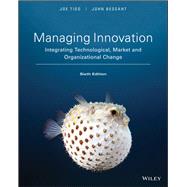Managing Innovation is the bestselling text for graduate and undergraduate students and a classic in the field. Emphasizing practical, evidence based tools and resources, this title provides students with the knowledge base to successfully manage innovation, technology, and new product development. The holistic approach addresses the interplay between the markets, technology, and the organization, while relating the unique skill set required to manage innovation and innovation processes.
The sixth edition of Managing Innovation continues to include the popular Innovation in Action sections in each chapter which are now newly titled Case Studies, and also features a number of new cases, updated and new research notes and references, and links to videos, audio interviews, activities, and case studies. The sixth edition also features new material on emerging innovation themes, including business model innovation, user innovation, crowd-sourcing, creativity, entrepreneurship, service innovation, public services, and more.
The rapid pace of the field's evolution has brought an increase in multi-disciplinary approaches and skills, while expanding the available tool kit and pushing the boundaries of possibility forward. This text provides expert navigation through the abundance of new data, new methods, new concepts, and approaches but it is designed to encourage and support tailored experimentation, not replace it. Equipped with a strong foundation and a productive innovation management mindset, todays students will be equipped to bring about the eras next great advances.








